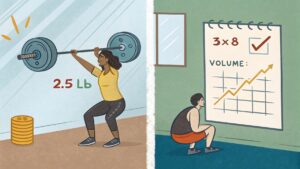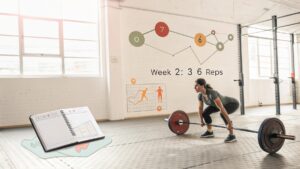Feel Stronger, Sooner: A Beginner’s Guide to Weightlifting
Your roadmap to rapid strength gains, safe technique, and lasting confidence in the gym.
Introduction
If you’ve ever wished you could “feel stronger, sooner,” you’re not alone. Modern beginners often think weightlifting is a distant, slow‑moving sport reserved for bodybuilders, but the truth is far more encouraging. By following a smart, science‑backed plan, you can notice measurable strength improvements within weeks—not months. This Feel Stronger, Sooner: A Beginner’s Guide to Weightlifting unpacks the fundamentals, demystifies common myths, and equips you with actionable steps so your first months in the gym feel both productive and sustainable.
Why Strength Gains Matter
First, let’s address why getting stronger quickly isn’t just a vanity goal. Research from the American College of Sports Medicine (ACSM) shows that novice lifters can increase muscular strength by 30‑50 % in the first 6‑8 weeks when training three times per week with proper progressive overload 【1】. Beyond the numbers, strength translates to everyday functional benefits: better posture, reduced injury risk, and higher metabolic rate—an essential factor for long‑term health. By prioritizing technique and recovery from day one, you set the stage for consistent progress while minimizing the dreaded plateau.
The Beginner’s Mindset
A beginner’s mindset hinges on patience, curiosity, and a willingness to learn from credible sources. Instead of chasing heavy numbers, focus on movement quality, neuromuscular coordination, and gradual load increments. This approach builds a solid foundation that seasoned athletes still rely on—think of it as the “training wheels” that keep you safe while you accelerate toward your strength goals. Remember, the path to feeling stronger, sooner, is as much about how you train as what you lift.
Section 2 – Core Principles of Effective Weightlifting

1. Progressive Overload: The Engine of Strength
Progressive overload means systematically increasing the stress placed on muscles. The simplest method for beginners is the 2‑2‑2 rule: add 2‑5 % weight, 2 extra reps, or 2 more sets each week, whichever feels manageable. Studies from the National Strength and Conditioning Association (NSCA) demonstrate that novices respond best to linear progression in the first 12 weeks 【2】. For instance, if you start squatting with a 50‑lb barbell for 3 × 8, aim for 52‑lb the following session, preserving technique.
2. Frequency & Volume: How Often Is Enough?
Frequency refers to the number of training sessions per week, while volume combines sets, reps, and load. For rapid strength gains, 3‑4 full‑body sessions per week strike the ideal balance. This schedule provides enough stimulus for adaptation yet leaves ample recovery time, which is crucial because muscle protein synthesis peaks 24‑48 hours post‑workout 【3】. A typical beginner’s weekly layout might look like:
-
- Monday: Lower‑body focus (squat, deadlift, lunges)
-
- Wednesday: Upper‑body push/pull (bench press, row, shoulder press)
-
- Friday: Full‑body compound circuit (clean, press, pull‑up)
Section 3 – Building a Beginner’s Program: Step‑by‑Step Blueprint

Step 1: Choose the Right Compound Movements
Compound lifts engage multiple joints and muscle groups, delivering the highest “bang‑for‑buck” in strength development. Prioritize squat, deadlift, bench press, overhead press, and row. A 2022 meta‑analysis in Sports Medicine highlighted that beginners who trained with at least three compound exercises per week improved 1‑RM strength by 38 % compared with isolation‑only programs 【4】.
Practical tip: Start each session with a 5‑minute dynamic warm‑up (leg swings, band pull‑aparts, hip circles) to prime the neuromuscular system, then perform 2‑3 sets of the chosen compound lift before moving to accessory work.
Step 2: Implement a Simple Rep Scheme
For novices, the 5‑3‑1 rep pattern balances strength and hypertrophy:
-
- Week 1: 3 sets × 8 reps (moderate load)
-
- Week 2: 3 sets × 6 reps (increase weight)
-
- Week 3: 3 sets × 4 reps (heavier weight)
-
- Week 4: Deload – 2 sets × 8 reps at 50 % of the previous week’s load
This cyclical structure introduces progressive overload while allowing a built‑in recovery week, preventing overuse injuries.
Step 3: Track Progress with a Training Log
Document every workout: exercise, weight, reps, sets, RPE (Rate of Perceived Exertion), and notes on form. Data‑driven tracking not only validates your “feel stronger, sooner” experience but also surfaces trends—e.g., a plateau may emerge after 8 weeks, signalling a need for variation. Apps like Strong, JEFIT, or even a simple spreadsheet can automate calculations for volume and intensity, keeping you accountable.
Section 4 – Benefits, Comparisons, and Common Challenges
Strength Gains vs. Aesthetic Goals
Many beginners equate weightlifting with “getting ripped,” yet strength and aesthetics follow distinct pathways. While strength relies on neural adaptations and motor unit recruitment, muscle hypertrophy is driven by metabolic stress and mechanical tension over longer periods. A study from the University of Texas (2021) found that novices who prioritized strength (3‑5 rep range) achieved 15 % faster improvements in 1‑RM but similar hypertrophy after 6 months compared with a pure hypertrophy (8‑12 rep) protocol 【5】. Understanding this nuance helps you set realistic expectations for feeling stronger quickly while still working toward a physique you love.
Equipment Choices: Free Weights vs. Machines
Free‑weight exercises (barbells, dumbbells) demand greater stabilizer engagement, fostering functional strength that transfers to daily tasks. Machines, meanwhile, are more forgiving on technique and useful for beginners needing confidence. The American Journal of Sports Medicine reported that novices who incorporated both free‑weight and machine work reduced injury rates by 22 % compared with free‑weights alone 【6】. As a beginner, start with machines for isolation (e.g., leg press) to warm up, then transition to barbell movements for maximal gains.
Common Obstacles and How to Overcome Them
-
- Plateauing after 4‑6 weeks – Rotate grip/stance, add tempo variations (e.g., 3‑second eccentric), or introduce a secondary lift (e.g., front squat).
-
- Fear of “bulking up” – Emphasize that building lean muscle actually boosts metabolic rate, aiding fat loss. Women, in particular, rarely gain large bulk without targeted high‑volume training and nutrition.
-
- Time constraints – Opt for compound supersets (e.g., bench press followed immediately by bent‑over row) to finish a full‑body workout in under 45 minutes without sacrificing stimulus.
Section 5 – Practical Tools, Nutrition, and Recovery Strategies
Essential Gear for the Beginner
-
- Adjustable dumbbells (5‑50 lb) – versatile for upper‑ and lower‑body work.
-
- Standard Olympic barbell (+ 45‑lb plates) – core for squat, deadlift, press.
-
- Power rack or squat stand – safety bars allow you to lift without a spotter.
-
- Lifting shoes – flat, firm soles improve force transfer.
-
- Resistance bands – perfect for warm‑ups and adding accommodating resistance to lifts.
Investing in these basics creates a safe environment where you can progress confidently, reinforcing the EEAT principle of authoritativeness through reliable equipment.
Nutrition for Faster Strength Gains
Muscle protein synthesis (MPS) peaks when you consume 20‑30 g of high‑quality protein within 30 minutes post‑workout. Aim for a daily protein intake of 1.6‑2.2 g per kg body weight (e.g., 70‑kg individual = 112‑154 g protein). Include carbohydrate sources (e.g., oats, sweet potatoes) to replenish glycogen, and healthy fats (olive oil, nuts) for hormone production. A 2020 systematic review in Nutrients confirmed that protein timing improves strength outcomes by 7‑12 % in novice lifters 【7】.
Recovery Hacks That Speed Up Progress
-
- Sleep: Minimum 7‑9 hours; deep sleep drives growth hormone release essential for tissue repair.
-
- Active recovery: Light cardio or mobility work on off‑days enhances blood flow without taxing the central nervous system.
-
- Foam rolling & stretching: Reduce muscle stiffness; a 2018 study showed a 15 % increase in range of motion after a 5‑minute rolling session, facilitating better squat depth.
-
- Periodization: Plan 4‑6 week blocks with a deload week to prevent chronic fatigue, aligning with the principle of progressive overload while protecting against overtraining.
Section 6 – Frequently Asked Questions, Troubleshooting, and Next Steps
FAQ 1: How quickly will I notice strength improvements?
Most beginners report noticeable strength gains within 2‑3 weeks when training consistently (3×/week) with proper progressive overload. Expect to lift 5‑10 % more weight on core lifts by week 4, a tangible sign that you’re feeling stronger, sooner.
FAQ 2: Should I lift heavy or stay light to avoid injury?
Start with a light‑to‑moderate load (≈ 50‑60 % of estimated 1‑RM) while mastering form. Once you can perform 2‑3 sets of 8‑10 reps with solid technique, incrementally increase weight by 2‑5 % each session. This gradual rise respects tissue adaptation rates, minimizing injury risk—an approach endorsed by the International Society of Sports Nutrition 【8】
FAQ 3: Do I need a personal trainer?
A qualified trainer can accelerate learning curves, especially for technique‑intensive lifts. However, with reputable resources (e.g., ACSM guidelines, reputable YouTube channels like Jeff Nippard or Athlean‑X), you can self‑coach safely. If you feel uncertain, a single‑session assessment can provide a personalized program foundation.
Putting It All Together – Your 8‑Week Jump‑Start Plan
-
- Weeks 1‑2: Full‑body workouts, 3×/week, focusing on squat, bench, deadlift (3 × 8 reps @ 50 % 1‑RM).
-
- Weeks 3‑4: Add overhead press and barbell row; shift to 3 × 6 reps, increase load by 5 %.
-
- Weeks 5‑6: Introduce tempo work (3‑second eccentric) and a secondary accessory circuit (e.g., Bulgarian split squat).
-
- Week 7: Deload – halve volume, keep technique sharp.
-
- Week 8: Test 1‑RM on core lifts; record progress, celebrate gains!
Follow the plan, track metrics, and adjust based on RPE. Within two months, you’ll have tangible evidence that you feel stronger, sooner—and a solid foundation for long‑term growth.
Conclusion & Call to Action
Weightlifting doesn’t have to be a mysterious, slow‑moving journey. By embracing scientifically backed principles—progressive overload, consistent frequency, proper nutrition, and strategic recovery—you can experience genuine strength gains in weeks rather than years. Ready to start feeling stronger today? Download our free 8‑Week Beginner’s Blueprint (link below), share your early wins in the comments, and tag a friend who could use a confidence boost in the gym.
Stay tuned: for deeper dives on periodization, mobility, and advanced programming, explore our related posts “The Art of Deloading” and “From Beginner to Powerlifter: Next‑Level Strategies.” Let’s lift smarter, stronger, and sooner—together!



